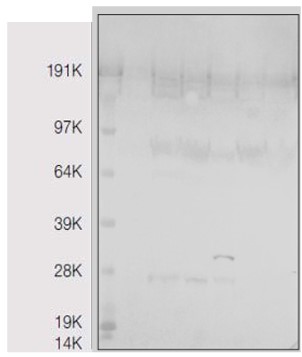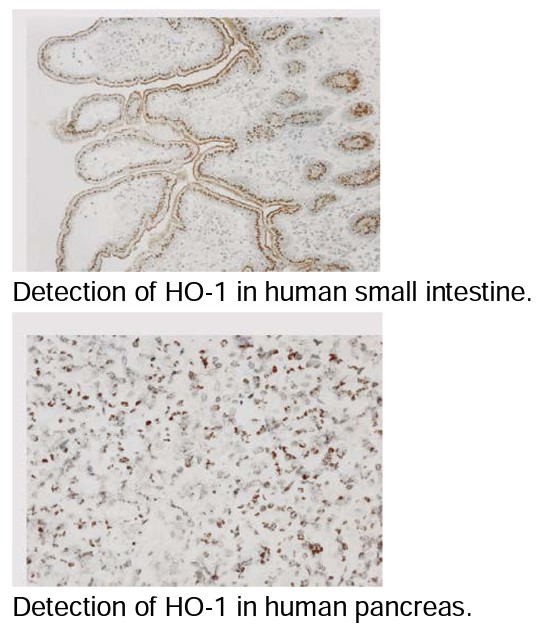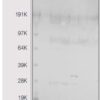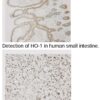Anti-Heme Oxygenase-1 Antibody (13060)
$509.00
SKU: 13060
Categories: Antibody Products, Enzymes and Enzyme Inhibitor Antibodies, Products
Overview
Product Name Anti-Heme Oxygenase-1 Antibody (13060)
Description Anti-Heme Oxygenase-1 Mouse Monoclonal Antibody
Target Heme Oxygenase-1
Species Reactivity Human, Mouse, Rat
Applications ELISA
Host Mouse
Clonality Monoclonal
Clone ID GTS-1
Isotype IgG1
Immunogen Microsomal fraction of transformed mouse T-cell transfected with rat heme oxygenase- 1 (WR19LrHO-1).
Properties
Form Lyophilized
Formulation PBS, pH 7.4, 1% BSA., lyophilized.
Buffer Formulation Phosphate Buffered Saline
Buffer pH pH 7.4
Buffer Protein Stabilizer 1% Bovine Serum Albumin
Format Purified
Purification Purified by immunoaffinity chromatography
Specificity Information
Specificity This antibody recognizes human, rat, and mouse HO-1. It does not recognize rabbit HO-1 and does not cross-react with HO-2.
Target Name Heme oxygenase 1
Target ID Heme Oxygenase-1
Uniprot ID P09601
Alternative Names HO-1, EC 1.14.14.18
Gene Name HMOX1
Accession Number NP_002124
Sequence Location Microsome, Endoplasmic reticulum membrane, Peripheral membrane protein, Cytoplasmic side
Biological Function Heme oxygenase cleaves the heme ring at the alpha methene bridge to form biliverdin. Biliverdin is subsequently converted to bilirubin by biliverdin reductase. Under physiological conditions, the activity of heme oxygenase is highest in the spleen, where senescent erythrocytes are sequestrated and destroyed. Exhibits cytoprotective effects since excess of free heme sensitizes cells to undergo apoptosis.
Research Areas Enzymes
Background Heme-oxygenase is an enzyme that catalyzes heme catabolism to yield biliverdin, iron, and carbon monoxide (CO). There are three isoforms of heme-oxygenase: HO-1, HO-2, and HO-3. HO-1 and HO-2 have been identified as the two major isoforms in mammals. HO-1, also known as heat shock protein 32 (Hsp32) is induced by most oxidative stress inducers, cytokines, inflammatory agents, and heat shock. HO-1 deficiency appears to cause reduced stress defense, a pro-inflammatory tendency, susceptibility to atherosclerotic lesion formation, endothelial cell injury, and growth retardation. Therefore, up-regulation of HO-1 is one of the major defense mechanisms against oxidative stress.
Application Images



Description Immunoblotting: use at 5-10ug/ml. A band of ~33kDa is detected. Detection of rat HO-1 with #13060 at 5ug/ml.

Description Immunohistochemistry: use at 5-10ug/ml on human frozen or paraffin-embedded tissue. Antigen retrieval with 0.4ug/ml Proteinase K.
Handling
Storage Stock solution of 2mg/ml should be stored for one (1) year at -20°C in appropriate aliquots to avoid multiple freeze-thaw cycles or at 4°C for 6 months with the addition of 0.1% sodium azide. Diluted antibody should not be stored.
Dilution Instructions Reconstitute lyophilized antibody using ultrapure to a final concentration no less than 100 ug/mL. Reconstitution with PBS or Tris buffer is acceptable if required. Protein carrier, biocide or cryopreservative can be added as needed. Aliquot and store at -20C for longterm storage. Dilute immediately prior to use.
Application Instructions Immunoblotting: use at 5-10ug/mL. A band of ~33kDa is detected.
Immunohistochemistry: use at 5-10ug/mL on human frozen or paraffin-embedded tissue. Antigen retrieval with 0.4ug/mL Proteinase K.
These are recommended concentrations.
Endusers should determine optimal concentrations for their applications.
Immunohistochemistry: use at 5-10ug/mL on human frozen or paraffin-embedded tissue. Antigen retrieval with 0.4ug/mL Proteinase K.
These are recommended concentrations.
Endusers should determine optimal concentrations for their applications.
References & Data Sheet
Data Sheet  Download PDF Data Sheet
Download PDF Data Sheet
 Download PDF Data Sheet
Download PDF Data Sheet





